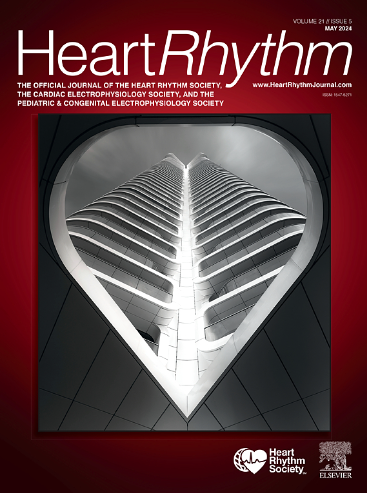Safety and feasibility of cardiac electrophysiology procedures in ambulatory surgery centers
IF 5.6
2区 医学
Q1 CARDIAC & CARDIOVASCULAR SYSTEMS
引用次数: 0
Abstract
Background
Despite their improved safety, by and large, cardiac electrophysiology procedures including catheter ablation (CA), are presently performed in hospital outpatient departments.
Objective
This large multicenter study investigated the safety and outcomes associated with various cardiac electrophysiology procedures performed at 6 ambulatory surgery centers (ASCs), primarily during the coronavirus disease 2019 pandemic under the Center for Medicare and Medicaid Services Hospitals Without Walls program.
Methods
We retrospectively analyzed the outcomes from consecutive electrophysiology procedures performed in ASCs with same-day discharge, including transesophageal echocardiography, cardioversion, cardiac implantable electronic device (CIED) implantation, electrophysiology studies, and CA for atrial fibrillation (AF), atrial flutter (AFL)/supraventricular tachycardia, ventricular premature complexes (VPCs), and atrioventricular node.
Results
Altogether, 4037 procedures were performed, including 779 transesophageal echocardiography/cardioversion procedures (19.3%), 1453 CIED implantation procedures (36.0%), 26 electrophysiology studies (0.6%), and 1779 CA procedures (44.1%) for AF (75.4%), AFL/supraventricular tachycardia (18.8%), VPC (4.7%), and atrioventricular node (1.1%). Overall, 80.2% of CA procedures were for left-sided atrial arrhythmias (AF/atypical AFL) requiring transseptal catheterization. Left-sided VPC ablation procedures (42.2%) were performed using a transseptal/retrograde approach. Adverse event rates were low, but comparable between CIED implantation and CA (0.76% vs 0.73%; P = .93), as were the incidences of urgent/unplanned postprocedure hospitalization (0.48% vs 0.45%; P = .89), respectively. Moreover, the adverse event rates in ASCs vs hospital outpatient departments did not differ for CIED (0.76% vs 0.65%; P = .71) or CA (0.73% vs 0.80%; P = .79).
Conclusion
The results from this large multicenter study suggest that ASCs represent a safe and effective setting to perform a variety of cardiac electrophysiology procedures including CA. These findings bear important implications for healthcare delivery and policy.
门诊手术中心心脏电生理程序的安全性和可行性。
背景:尽管安全性有所提高,但包括导管消融术(CA)在内的大多数心脏电生理手术目前都是在医院门诊部(HOD)进行的:这项大型多中心研究调查了在 6 家非住院手术中心(ASC)进行的各种心脏电生理手术的安全性和结果,主要是在 COVID-19 大流行期间根据 CMS 无墙医院计划进行的:我们回顾性分析了在当天出院的非住院手术中心进行的连续电生理学手术的结果,包括经食道超声心动图 (TEE)、心脏电复律、心脏植入式电子设备 (CIED) 植入、电生理学研究 (EPS) 以及心房颤动 (AF)、心房扑动 (AFL)/ 室上性心动过速 (SVT)、室性早搏 (VPC) 和房室结的 CA。结果:共进行了 4,037 例手术,包括 779 例 TEE/心脏剥离术(19.3%)、1,453 例 CIED 植入术(36.0%)、26 例 EPS(0.6%)和 1,779 例 CA(44.1%),分别用于治疗房颤(75.4%)、AFL/SVT(18.8%)、VPC(4.7%)和房室结(1.1%)。总体而言,80.2%的CA是针对左侧房性心律失常(房颤/典型房颤),需要进行经皮导管术。左侧 VPC 消融(42.2%)采用经皮/逆行方法进行。不良事件发生率较低,但CIED和CA的不良事件发生率相当(0.76% vs. 0.73%; P=0.93),术后紧急/计划外住院的发生率也相当(0.48% vs. 0.45%; P=0.89)。此外,ASC与HOD的不良事件发生率在CIED(0.76% vs. 0.65%;P=0.71)或CA(0.73% vs. 0.80%;P=0.79)方面没有差异:这项大型多中心研究的结果表明,ASC 是进行包括 CA 在内的各种心脏电生理手术的安全有效的场所。这些研究结果对医疗服务和政策具有重要意义。
本文章由计算机程序翻译,如有差异,请以英文原文为准。
求助全文
约1分钟内获得全文
求助全文
来源期刊

Heart rhythm
医学-心血管系统
CiteScore
10.50
自引率
5.50%
发文量
1465
审稿时长
24 days
期刊介绍:
HeartRhythm, the official Journal of the Heart Rhythm Society and the Cardiac Electrophysiology Society, is a unique journal for fundamental discovery and clinical applicability.
HeartRhythm integrates the entire cardiac electrophysiology (EP) community from basic and clinical academic researchers, private practitioners, engineers, allied professionals, industry, and trainees, all of whom are vital and interdependent members of our EP community.
The Heart Rhythm Society is the international leader in science, education, and advocacy for cardiac arrhythmia professionals and patients, and the primary information resource on heart rhythm disorders. Its mission is to improve the care of patients by promoting research, education, and optimal health care policies and standards.
 求助内容:
求助内容: 应助结果提醒方式:
应助结果提醒方式:


